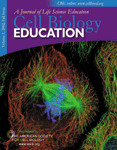Book Review: Guidebook to Modern Microscopy
This book provides reliable information about the fundamentals of a subject that many of our students need to learn. Both theoretical and practical aspects of the subject are treated with economy, clarity, and authority. In a fast-moving field like light microscopic imaging of biological material, even established professionals may find this book both a helpful refresher on things they have long known and a useful introduction to new twists on an old trade.
Since the 1980s there has been a renaissance in biological light microscopy. Many of the reasons for this change are grounded in technological advances, such as dyes of improved specificity and sensitivity, novel optics that increase contrast or minimize the impact of out-of-focus material, and cameras that greatly increase the sensitivity of detection. As a result, several new technologies must be understood. Few biologists have the time or inclination to master them all, so we rely on expert advice to select a microscope or an optical system, to choose a fluorescent tag, or to purchase an electronic camera. One serious potential problem with this approach is that we may not understand enough about the devices and methods at hand to recognize their limitations and problems, which may lead to difficulties in data interpretation. Thus, understanding the foundations of modern cellular imaging is important for doing many kinds of modern cell biology. Even scientists who identify themselves as molecular biologists, geneticists, biochemists, physiologists, or neuroscientists now rely on light microscopy, although they may not have taken the time to learn about the technologies upon which imaging relies.
Murphy's book is unusual because it provides a technically sound and simply conceived introduction to virtually every link in the chain of technologies that makes modern imaging so powerful. This chain ranges from the classic notions of fixation and staining, through the physics of lens imaging and phase contrast, on to polarization and differential interference contrast optics, then to fluorescence confocal microscopy, photomultiplier tubes, intensified video devices, and modern charge-coupled device (CCD) cameras. The characteristics of fluorescent molecules that provide such fascinating image detail, including the green fluorescent protein, are also spelled out. This book will provide individuals without background knowledge in optical physics, electronics, or image processing with many of the basic facts they need to know to understand both the power and the limitations of their images. Such facts and principles must be known for us to avoid trouble from cryptic experimental details. Thus, the book will be useful for students and professional cell biologist alike.



